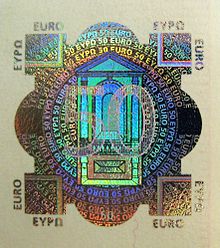
Back طباعة أمنية Arabic Sicherheitsmerkmale von Banknoten German Turvapaino Finnish Druk zabezpieczony Polish Защищённая полиграфия Russian Varnostno tiskanje Slovenian 防伪印刷 Chinese

This article needs additional citations for verification. (November 2022) |
Security printing is the field of the printing industry that deals with the printing of items such as banknotes, cheques, passports, tamper-evident labels, security tapes, product authentication, stock certificates, postage stamps and identity cards. The main goal of security printing is to prevent forgery, tampering, or counterfeiting. More recently many of the techniques used to protect these high-value documents have become more available to commercial printers, whether they are using the more traditional offset and flexographic presses or the newer digital platforms. Businesses are protecting their lesser-value documents such as transcripts, coupons and prescription pads by incorporating some of the features listed below to ensure that they cannot be forged or that alteration of the data cannot occur undetected.
A number of technical methods are used in the security printing industry.[1] Security printing is most often done on security paper, but it can also occur on plastic materials.
- ^ "EUIPO Anti-Counterfeiting Technology Guide". European Observatory on Infringements of Intellectual Property Rights. 2021-02-26.
© MMXXIII Rich X Search. We shall prevail. All rights reserved. Rich X Search